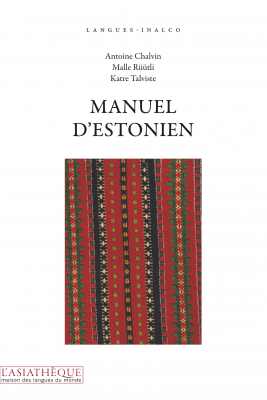Details
Format: Paperback
ISBN: 9782360570201
Collection: Langues INALCO
16 x 24 cm
Weight: 441 gr
Pages: 256
First publication: 09/11/2011
Last printing: 07/2018
Manuel d'estonien (Livre + CD MP3)
Estonian, the official language of Estonia, is the mother tongue of approximately one million people. It is also spoken today by most of the Russian community speakers in Estonia. Its origins rank it with Hungarian and Finnish, among the Finno-Ugric languages. This manual, developed by teachers from Institut National des Langues et Civilisations Orientales (INALCO), addresses to people wishing to acquire a basic skill in Estonian, corresponding to the first year of study at Inalco (A2 of the Common European Framework of Reference for Languages). The lessons are divided into five parts (grammar, exercises, dialogues from the grammatical forms studied, self-expression, authentic text). The dialogues and exercises refer to key situations and major themes of everyday life. An Estonian-French glossary appears at the end of the book. A Mp3 CD with recordings of dialogues and texts is added to the work. Keys to the exercises (in French) are available for free here. Antoine Chalvin is Professor of Estonian and Finnish Languages and Literatures at INALCO. Malle Rüütli, reader at Inalco from 2003 to 2007, teaches at the center of the Estonian language University of Tartu. Katre Talviste, reader of Estonian at INALCO from 2007 to 2012, is a literature researcher at the University of Tartu. Original artwork by Kadri Mõõr.
CONTRIBUTORS' BIOGRAPHIES
Antoine Chalvin
Antoine Chalvin (born January 3, 1966 in Orange) is a university professor, specializing in Estonian and Finnish languages and literatures at the National Institute of Oriental Languages and Civilizations in Paris. He is responsible for the Estonian Studies section and is a translator from Estonian into French.
TABLE OF CONTENTS
Avant-propos
Leçon 1
1. Alphabet et prononciation • 2. Longueur des consonnes et des voyelles • 3. La « mouillure » • 4. L’accent tonique • 5. Pronoms personnels sujets • 6. Infinitifs – présent de l’indicatif – verbe olema
Leçon 2
1. Déclinaison – génitif singulier – nominatif singulier et pluriel • 2. L’alternance intersyllabique – degré fort et degré faible • 3. Les démonstratifs see et need • 4. Les pronoms interrogatifs et relatifs kes et mis • 5. Prépositions et postpositions
Leçon 3
1. Le génitif des pronoms personnels • 2. Les cas locaux statiques • 3. Construction équivalente au verbe avoir – adessif des pronoms personnels • 4. Accord de l’adjectif
Leçon 4
1. Les cas locaux dynamiques • 2. L’illatif bref • 3. Emplois non spatiaux des cas locaux dynamiques • 4. Les cas locaux des pronoms personnels
Leçon 5
1. Le partitif singulier des substantifs et des adjectifs • 2. Le partitif des pronoms
Leçon 6
1. L’impératif • 2. Les nombres cardinaux au nominatif
Leçon 7
1. Le comitatif • 2. L’abessif • 3. Le participe présent • 4. Déclinaison des
pronoms kes et mis • 5. Le possessif oma
Leçon 8
1. Le génitif pluriel • 2. Le pluriel des autres cas • 3. Adjectifs invariables
Leçon 9
1. Le participe passé actif • 2. Le passé composé • 3. Le translatif
Leçon 10
Le prétérit
Leçon 11.
1. Le comparatif des adjectifs • 2. Le superlatif des adjectifs • 3. L’expression de la comparaison • 4. Verbes à particule et locutions verbales
Leçon 12
Le partitif pluriel
Leçon 13
1. Les cas du complément d’objet • 2. Cas particulier des pronoms personnels objets • 3. Les procédés de formation des mots
Leçon 14
1. Le conditionnel présent • 2. Le conditionnel passé • 3. Emplois du conditionnel • 4. La place du verbe dans la phrase
Leçon 15
1. Emplois du premier infinitif • 2. Les formes déclinées du 1er infinitif et leurs emplois • 3. Emplois du 2e infinitif • 4. Le gérondif
Leçon 16
1. Le participe passé passif • 2. Le participe passé passif employé comme épithète • 3. L’expression de l’heure
Leçon 17
1. La personne indéterminée au présent de l’indicatif • 2. La personne indéterminée au prétérit • 3. La personne indéterminée au passé composé et au plus-que-parfait • 4. Le complément d’objet total d’un verbe à la personne indéterminée
Leçon 18
1. La déclinaison des nombres cardinaux • 2. Les nombres ordinaux • 3. Les
nombres fractionnaires
Leçon 19.
1. L’essif • 2. Le terminatif • 3. La personne indéterminée au conditionnel • 4. La personne indéterminée à l’impératif
Leçon 20
1. Le comparatif des adverbes • 2. Le superlatif des adverbes • 3. Le pronom ise
Leçon 21
1. Le participe présent passif • 2. Les semi-propositions en -vat • 3. Les pronoms réciproques
Leçon 22
1. Le mode oblique • 2. Les rapports entre les formes verbales • 3. La particule -gi/-ki
Annexe : le système casuel
Bibliographie
Lexique














